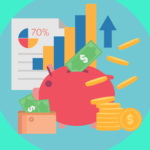
The pool of different assets owned by an individual investor or an organisation is called portfolio. This pool may consist of stocks, bond, cash equivalents, precious metals, commodities and different types of funds such as mutual funds, exchange-traded funds etc.
For example, let an investor owns few shares of Tata Motors and ICICI Bank, some mutual funds, few acres of farmland, have some amount as hard cash and a small amount of gold/silver, then all these assets owned by this investor will collectively be called as his portfolio.
Portfolio Diversification
It is advisable to make a diversified investment to reduce the risk factor. As the famous maxim says “Do not put all your eggs in a single basket.”
A non-diversified investment carries a higher risk than a well-diversified one. For example, an investor who invests only in stocks will be at high risk in case of equity market crash, in comparison to another investor who invests in stocks, bonds, and real estate.
So it is a good idea to diversify your portfolio over a range of securities rather than putting all your savings in a single type of investment option.
The diversification prevents your losses in times when the market conditions are not favorable for a particular type of investment vehicle.
Creating Your Portfolio
The pattern of a portfolio may be different for different investors. An investor should keep in mind their risk tolerance, investment goals, and time horizon while creating their portfolio.
The investor who cannot bear potential losses in case of an adverse market fluctuation should avoid investing in risky asset classes.
Your risk tolerance is one of the most critical parameters while creating your portfolio.
An investor should know the risk level involved in different asset classes. Investors who do not want to take much risk should select safer assets to invest their money.
An investor’s investment goal is another critical parameter while creating a portfolio. Generally, high-risk investments provide a higher average return. But the portfolio should be balanced one between risk and return.
An investor’s investments must be synchronized with his long-term and short-term goals.
The behavior of an investment vehicle can change over time so the returns this should be kept in mind while taking your long-term investment decisions. A long-term portfolio must be analyzed from time to time by investors.
Synchronizing the Portfolio With Investors’ Time Horizon
Investor’s time horizon is also an essential factor in creating a portfolio. An investor who starts investing early can choose some high-risk, high return vehicles such as growth stocks, IPOs, investing in emerging markets, high yield bonds etc.
Because a young investor will have enough time to recover his losses and he can save more by increasing his income sources through extra efforts. On the other hand, the investor who starts late in his career cannot tolerate much risk because he cannot stay invested for a more extended period.
For example, an investor who has invested his retirement fund cannot take much risk on this money. He will require this money for his daily needs because he is not the part of workforce anymore and he is not getting any regular wage.
This type of investors should create their portfolio by choosing safer investment options such as large-cap stocks, fixed deposits, government bonds, safe index funds etc.
Read also: 5 Best Virtual Trading Websites For Indian Stock Market



